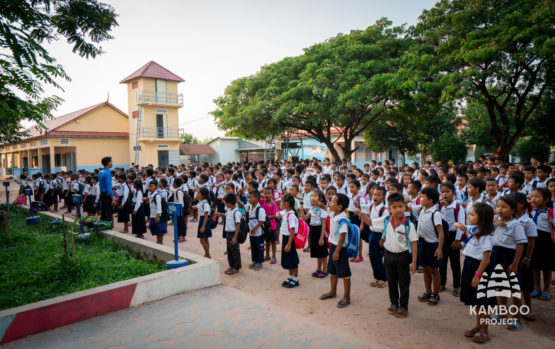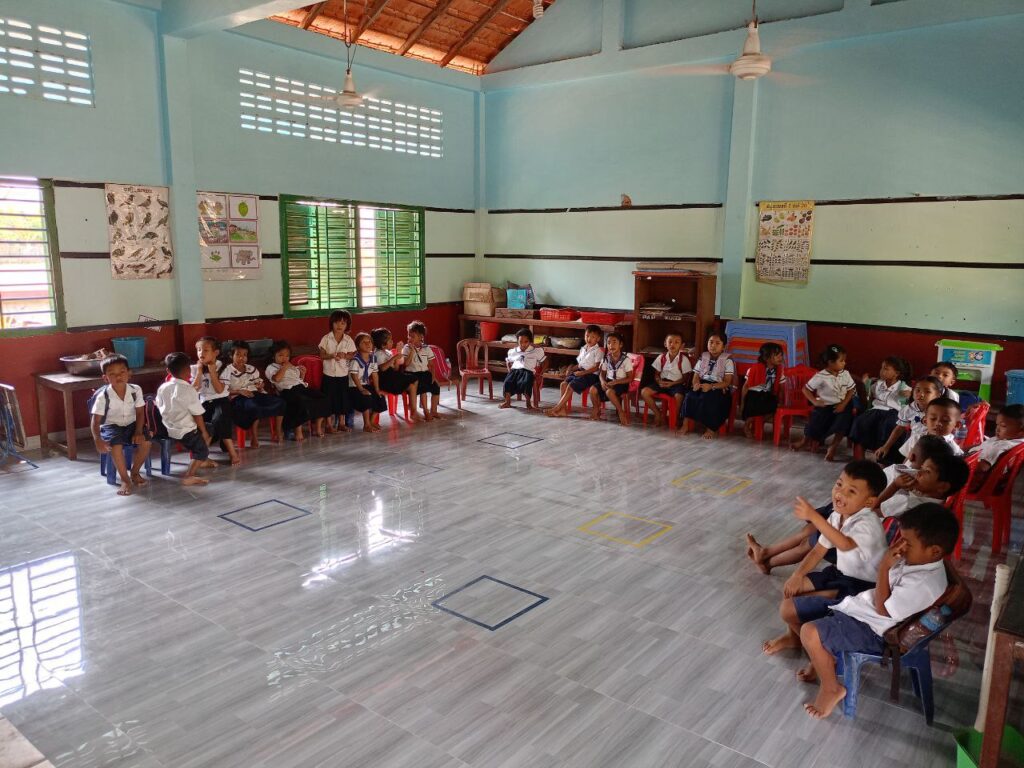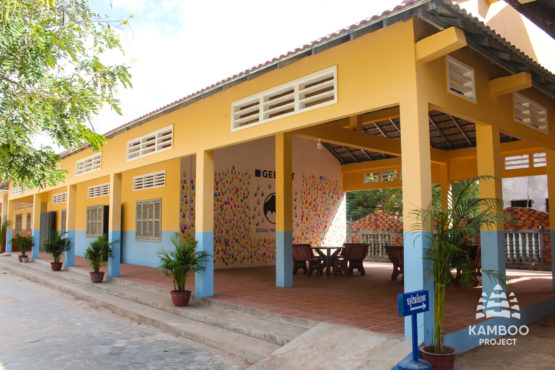Project for school construction and renovation
Building Futures: Constructing and Renovating Schools for Rural Cambodia
In Cambodia, inadequate school infrastructure poses a significant barrier to education. Many students must travel long distances to attend school, which contributes to high dropout rates.
Rural children often find themselves in makeshift classrooms built from flimsy materials – or, if they are lucky, in overcrowded learning spaces. Overcrowded classrooms make it challenging for teachers to provide individual attention, while insufficient furniture and learning resources hinder student engagement and participation. Furthermore, the absence of proper fencing heightens the risk of flooding and damage to existing infrastructure.
Additionally, well-maintained school kitchens encourage students to stay on campus, promoting healthy eating habits and fostering social interactions. By constructing school buildings, Kamboo Project aims to enhance educational opportunities for rural children in Cambodia.
Background
From mats to buildings
In the rural corners of Cambodia, the lack of school buildings, notably classrooms and teacher dormitories, stands as an insurmountable hurdle to education. The children gather under the shade of a tree, their makeshift classroom consisting of a few worn-out mats on the ground. With no walls to protect them from the elements, they endure sweltering heat, torrential rains, and biting winds that threaten to extinguish their educational flame.
Inside this makeshift sanctuary, resources are scarce. A single blackboard, faded and cracked, serves as the focal point for their lessons. The students huddle together, straining their eyes to catch a glimpse of the teacher’s words, their thirst for knowledge competing with the limited space and resources available.
Central Challenge
Lack of infrastructure
The absence of proper school infrastructure not only undermines the quality of education but also poses significant risks to the children’s safety and well-being. The dilapidated conditions of these improvised classrooms make them vulnerable to collapse, endangering the lives of these young learners who seek refuge within their walls.
Moreover, the lack of proper facilities hampers the learning experience. Without functional libraries, computer labs, or science laboratories, the children are deprived of the tools and resources necessary to explore and expand their horizons. Their dreams of becoming doctors, engineers, or teachers remain distant aspirations, as their access to practical knowledge and hands-on learning opportunities is severely limited.


Strategy
Breaking down barriers to learning
The impact reverberates beyond the classroom walls. The absence of school infrastructure perpetuates a cycle of educational disadvantage, hindering the community’s progress and development. The lack of access to quality education limits the potential of these rural areas, stifling economic growth, and impeding social mobility. The bright minds of tomorrow remain trapped in a cycle of poverty, their potential unrealized and their contributions to society restained.
With the school building and renovation project, Kamboo Project aims to dismantle these barriers to learning and provide rural children in Cambodia with the essential educational environments they deserve. By constructing school buildings in the areas where they are needed most, we can create safe, conducive, and inspiring spaces that significantly improve educational outcomes for children in rural communities.
Implementation and monitoring
Everything starts with a safe learning environment. No other projects can be launched until a school building is safe. As such, the building project is our longest-standing project to date––we began in 2015/16 and have done building and repair work at 20 of the 45 primary schools in the Prasat Bakong District, plus one each in the Varin district and the province of Banteay Meanchey. As this project is our most capital-intensive one, we often team up with other NGOs and/or corporate sponsors whose Corporate Socials Investment mission fits with our program. Our two corporate sponsors for building and construction work are Geberit and Sika.

Example projects
To name four examples:
- In 2023, we partnered with the Swiss NGO, “Child’s Dream,” to construct a new classroom for $40,000 at the Phum Peak 4 Primary School, jointly funded by donors to both NGOs (see https://kamboo-project.ngo/en/opening-ceremony-at-phum-pheak-4-primary-school/).
- Also, in 2023, Sika sponsored the construction of new floors for all classrooms at two schools.
- In 2019 and (ongoing at the time of writing) in 2024, we were awarded the “Geberit Social Project.” Alongside the installation of sanitary facilities, a dozen Geberit apprentices traveled to Cambodia to set up classrooms at three primary schools, collectively serving over 3,000 students.
- Last but not least, in 2023/24, Z‘Bären Küchen, a Swiss maker of kitchens, teamed up with Kamboo Project to renovate the kitchen and cafeteria at Lvia Primary School.
We also like to highlight that over the past decade, we have gained significant expertise in collaborating with local suppliers and local authorities, in order to ensure both cost-effective and legally sound implementation of such meaningful projects.
Finally, to support independence and stimulate intrinsic motivation, we ask for a „buy-in“ by the respective school management teams. This can come in the form of a financial contribution through fundraising events with surrounding communities and parents, or participation in building works through volunteering. For example, during the renovation of the Ta Ei Primary School, the highly motivated principal raised almost 20% of total investment needs through various community funding initiatives.
Once this infrastructure work is completed, we roll out our other programs, including hygiene education, school gardens, and bicycle distribution. We therefore have plenty of reasons and opportunities to visit the renovated schools and monitor the state of the school infrastructure on an ongoing basis. We initiate repair or maintenance work where we deem appropriate. The most common type of repair work we undertake is roof repair.
Budget
The detailed budget for one building with three classrooms is outlined below:
| No. | Description | Amount | Total Cost | $36,000 |
|---|---|---|
| 1 | Preparation of building site | $330 |
| 2 | Foundation construction | $2.051 |
| 3 | Preparation of wall bricks to hold ground | $450 |
| 4 | Beam foundation | $2.048 |
| 5 | Floor construction | $2.000 |
| 6 | Building concrete pillars | $819 |
| 7 | Preparation of wall bricks | $1.770 |
| 8 | Beam foundation-Surface above of the building | $1.649 |
| 9 | Roof work part 1 | $660 |
| 10 | Roof work part 2 | $4.407 |
| 11 | Plastering the walls | $1.056 |
| 12 | Floor tile work | $855 |
| 13 | Window and door installation | $4.707 |
| 14 | Window and door painting | $158 |
| 15 | Paint for the entire building | $1.161 |
| 16 | Labor work | $11.880 |
Additional features:
- The construction of a school fence surrounding the entire school area costs between $1,000 and $3,000, depending on the cost of labor.
- A proper kitchen and cafeteria infrastructure warrants investment of between $ 2,500 and $ 6,000, depending on the size of the school.
- The renovation of a roof of a classroom can cost up to $5,000.
